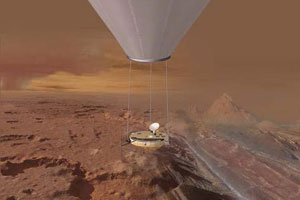 Artist concept of a balloon-borne Titan probe. Credit: NASA, JPL/Corby Waste
Artist concept of a balloon-borne Titan probe. Credit: NASA, JPL/Corby Waste
Possible “cryovolcano” on Saturn’s moon, Titan! This little moon just keeps getting more and more interesting.
Since 2004, when NASA’s Cassini spacecraft and the European Huygens lander started exploring Saturn’s largest satellite, Titan, layer after layer of the mysterious moon have been peeled away, revealing what has turned out to be an awesome alien world that stands apart from all other moons in the solar system--and even holds its own with the planets.
Cryovolcanoes: cool! Imagine a 3000 foot tall mountain gushing freezing water-ammonia slush, which pours down its slopes to become solid “rock ice” flows as it freezes, and spouting a plume of water vapor that quickly turns into snow. Is that really how a volcano of cold water, ice, and maybe ammonia and methane would behave? Maybe, maybe not—but now scientists have observational evidence of what might be such a process on Titan, and the similarities in patterns to Earthly lava flows is compelling. Take a look at the video….
The thought makes me want to go and explore Titan right now!
At the annual American Geophysical Union (AGU) conference in San Francisco last December, I voiced a concern to a presenter who was describing explorations of Titan by Cassini and Huygens. My concern was that, though the images returned by Huygens from the surface of that frigid smoggy world were unprecedented up-close views of a distant alien land, I fear that with the cost of space missions and budgets and economies and all, we might not return there for further exploration within my lifetime…and I’d have to make do with the images from Huygens. (Though very cool images, they were essentially from a spot on Titan that is little more than a plane of soil and pebbles; I want lakes and volcanoes!)
